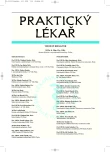Mentalization
Authors:
F. Koukolík
Authors‘ workplace:
Primář: MUDr. František Koukolík, DrSc.
; Národní referenční laboratoř prionových chorob
; Fakultní Thomayerova nemocnice s poliklinikou, Praha
; Oddělení patologie a molekulární medicíny
Published in:
Prakt. Lék. 2008; 88(10): 566-571
Category:
Reviews
Overview
This paper attempts to describe a neuroanatomical model of so called mentalization (e.g. theory of mind). Developmental autism is an example of mentalization disorder. Model is composed of a „receptive“ temporal and parietal and an execution component subserved by prefrontal regions. Information processed in posterior regions is relayed through a limbic–paralimbic system. The proposed model accounts for the ability to mentalize about both the self and others.
Key words:
Mentalization, theory of mind, neuroanatomical model.
Sources
1. Abu-Akel, A. A Neurobiological mapping of theory of mind. Brain Research Reviews 2003, 43, p. 29-40.
2. Apperly, I.A., Samson, D., Chiavarino, C. et al. Frontal and temporoparietal lobe contributions to theory of mind: neuropsychological evidence from a false-belief task with reduced and executive demands. J. Cognitive Neurosciences 2004, 16, p. 1773-1784.
3. Apperly, I.A. Beyond simulation-theory and theory-theory: why social cognitive neuroscience should use its own concepts to study „theory of mind“? Cognition 2007, 107, p. 266-283.
4. Calland, J., Tomasello, M. Does the chimpanzee have a theory of mind? 30 year later. Trends in Cognitive Science 2008, 12, p. 187-192.
5. Gallese, V. Before and below „theory of mind“: embodied simulation and the neural correlated of social cognition. Phil. Trans. R. Soc. B. 2007, 362, p. 659–669. Dostupné z WWW: http://www. unipr.it/arpa/mirror/pubs/pdffiles/Gallese/PhilTrans2007.pdf.
6. Keyers, Ch., Gazzola, V. Integrating simulation and theory of mind: from self to social cognition. Trends in Cognitive Science 2007, 11, p. 194-196.
7. Kobayashi, C., Glover, G.H., Temple, E. Children´s and adult´s neural bases of verbal and nonverbal „theory of mind“. Neuropsychologia 2007, 45, p. 1522-1532.
8. Kobayashi, C., Glover, G.H., Temple, E. Cultural and linguistic effects on neural bases of ‘Theory of Mind’ in American and Japanese children. Brain Res. 2007, 1164, p. 95-107.
9. Koukolík, F. Sociální mozek. Praha: Karolinum, 2006; ISBN 80-246-1242-9.
10. Koukolík, F. Před úsvitem, po ránu. Eseje o dětech a rodičích. Praha: Karolinum, 2008; ISBN 978-80-246-1496-0.
11. Krach, S., Hegel, F., Wrede, B. et al. Can machines think? Interaction and perspective talking with robots investigated via fMRI. PLoS ONE 2008, 3(7), e 2597. doi:10.1371/journal.pone.0002597. Dostupné z WWW: http://www.pubmedcentral.nih. gov/articlerender.fcgi?artid=2440351.
12. Lissek, S., Peters, S., Fuchs, N. et al. Cooperation and deception recruits different subsets of the theory-of-mind network. PloS 3(4) 2008, e 2023. doi, 10. 1371/journal. pone. 0002023. Dostupné z WWW: http://www.plosone.org/journals/plosone/article/info%3Adoi%2F10.1371%2Fjournal.pone; 0002023.
13. Penn, D.C., Povinelli, D.J. On the lack of evience that non-human animals possess anything remotely resembling a „theory of mind“? Phil. Trans. R. Soc. B. 2007, 362, p. 736-744.
14. Sanfey, A.G., Rilling, J.K.,. Aronson, J.A. et al. The neural basis of economic decision-making in the Ultimatum game. Science 2003, 300, p. 1755-1758.
15. Saxe, R., Carey, S., Kahnwisher, N. Understanding other minds: linking developmental psychology and functional neuroimaging. Annu Rev. Psychol. 2004, 55, 04. 1-4. p. 38.
16. Rilling, J.K., Sandry, A.G., Aronson, J.A. et al. The neural correlates of theory of mind within interpersonal interaction. NeuroImage 2004, 22, p. 1694-1703.
Labels
General practitioner for children and adolescents General practitioner for adultsArticle was published in
General Practitioner

2008 Issue 10
Most read in this issue
- Guillain-Barré syndrome. Specific features of intensive care, potential for therapeutic use of plasmapheresis, and our experience
- Common basic classifications of child fractures
- Mentalization
- Uncommon nasopharyngeal tumor in old age - nasopharyngeal angiofibroma?
